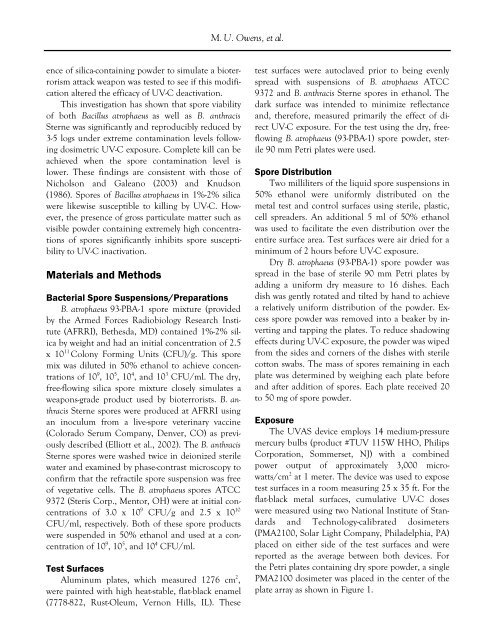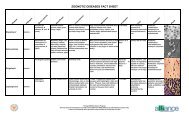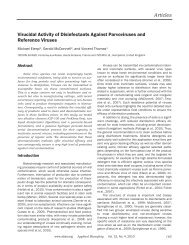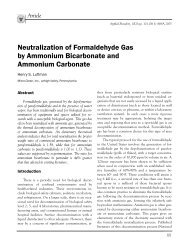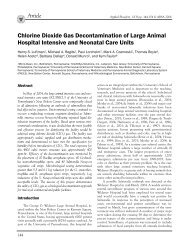Volume 10, Number 4, 2005 - American Biological Safety Association
Volume 10, Number 4, 2005 - American Biological Safety Association
Volume 10, Number 4, 2005 - American Biological Safety Association
You also want an ePaper? Increase the reach of your titles
YUMPU automatically turns print PDFs into web optimized ePapers that Google loves.
ence of silica-containing powder to simulate a bioterrorism<br />
attack weapon was tested to see if this modification<br />
altered the efficacy of UV-C deactivation.<br />
This investigation has shown that spore viability<br />
of both Bacillus atrophaeus as well as B. anthracis<br />
Sterne was significantly and reproducibly reduced by<br />
3-5 logs under extreme contamination levels following<br />
dosimetric UV-C exposure. Complete kill can be<br />
achieved when the spore contamination level is<br />
lower. These findings are consistent with those of<br />
Nicholson and Galeano (2003) and Knudson<br />
(1986). Spores of Bacillus atrophaeus in 1%-2% silica<br />
were likewise susceptible to killing by UV-C. However,<br />
the presence of gross particulate matter such as<br />
visible powder containing extremely high concentrations<br />
of spores significantly inhibits spore susceptibility<br />
to UV-C inactivation.<br />
Materials and Methods<br />
Bacterial Spore Suspensions/Preparations<br />
B. atrophaeus 93-PBA-1 spore mixture (provided<br />
by the Armed Forces Radiobiology Research Institute<br />
(AFRRI), Bethesda, MD) contained 1%-2% silica<br />
by weight and had an initial concentration of 2.5<br />
x <strong>10</strong> 11 Colony Forming Units (CFU)/g. This spore<br />
mix was diluted in 50% ethanol to achieve concentrations<br />
of <strong>10</strong> 9 , <strong>10</strong> 5 , <strong>10</strong> 4 , and <strong>10</strong> 3 CFU/ml. The dry,<br />
free-flowing silica spore mixture closely simulates a<br />
weapons-grade product used by bioterrorists. B. anthracis<br />
Sterne spores were produced at AFRRI using<br />
an inoculum from a live-spore veterinary vaccine<br />
(Colorado Serum Company, Denver, CO) as previously<br />
described (Elliott et al., 2002). The B. anthracis<br />
Sterne spores were washed twice in deionized sterile<br />
water and examined by phase-contrast microscopy to<br />
confirm that the refractile spore suspension was free<br />
of vegetative cells. The B. atrophaeus spores ATCC<br />
9372 (Steris Corp., Mentor, OH) were at initial concentrations<br />
of 3.0 x <strong>10</strong> 9 CFU/g and 2.5 x <strong>10</strong> <strong>10</strong><br />
CFU/ml, respectively. Both of these spore products<br />
were suspended in 50% ethanol and used at a concentration<br />
of <strong>10</strong> 9 , <strong>10</strong> 5 , and <strong>10</strong> 4 CFU/ml.<br />
Test Surfaces<br />
Aluminum plates, which measured 1276 cm 2 ,<br />
were painted with high heat-stable, flat-black enamel<br />
(7778-822, Rust-Oleum, Vernon Hills, IL). These<br />
M. U. Owens, et al.<br />
test surfaces were autoclaved prior to being evenly<br />
spread with suspensions of B. atrophaeus ATCC<br />
9372 and B. anthracis Sterne spores in ethanol. The<br />
dark surface was intended to minimize reflectance<br />
and, therefore, measured primarily the effect of direct<br />
UV-C exposure. For the test using the dry, freeflowing<br />
B. atrophaeus (93-PBA-1) spore powder, sterile<br />
90 mm Petri plates were used.<br />
Spore Distribution<br />
Two milliliters of the liquid spore suspensions in<br />
50% ethanol were uniformly distributed on the<br />
metal test and control surfaces using sterile, plastic,<br />
cell spreaders. An additional 5 ml of 50% ethanol<br />
was used to facilitate the even distribution over the<br />
entire surface area. Test surfaces were air dried for a<br />
minimum of 2 hours before UV-C exposure.<br />
Dry B. atrophaeus (93-PBA-1) spore powder was<br />
spread in the base of sterile 90 mm Petri plates by<br />
adding a uniform dry measure to 16 dishes. Each<br />
dish was gently rotated and tilted by hand to achieve<br />
a relatively uniform distribution of the powder. Excess<br />
spore powder was removed into a beaker by inverting<br />
and tapping the plates. To reduce shadowing<br />
effects during UV-C exposure, the powder was wiped<br />
from the sides and corners of the dishes with sterile<br />
cotton swabs. The mass of spores remaining in each<br />
plate was determined by weighing each plate before<br />
and after addition of spores. Each plate received 20<br />
to 50 mg of spore powder.<br />
Exposure<br />
The UVAS device employs 14 medium-pressure<br />
mercury bulbs (product #TUV 115W HHO, Philips<br />
Corporation, Sommerset, NJ) with a combined<br />
power output of approximately 3,000 microwatts/cm<br />
2 at 1 meter. The device was used to expose<br />
test surfaces in a room measuring 25 x 35 ft. For the<br />
flat-black metal surfaces, cumulative UV-C doses<br />
were measured using two National Institute of Standards<br />
and Technology-calibrated dosimeters<br />
(PMA2<strong>10</strong>0, Solar Light Company, Philadelphia, PA)<br />
placed on either side of the test surfaces and were<br />
reported as the average between both devices. For<br />
the Petri plates containing dry spore powder, a single<br />
PMA2<strong>10</strong>0 dosimeter was placed in the center of the<br />
plate array as shown in Figure 1.


